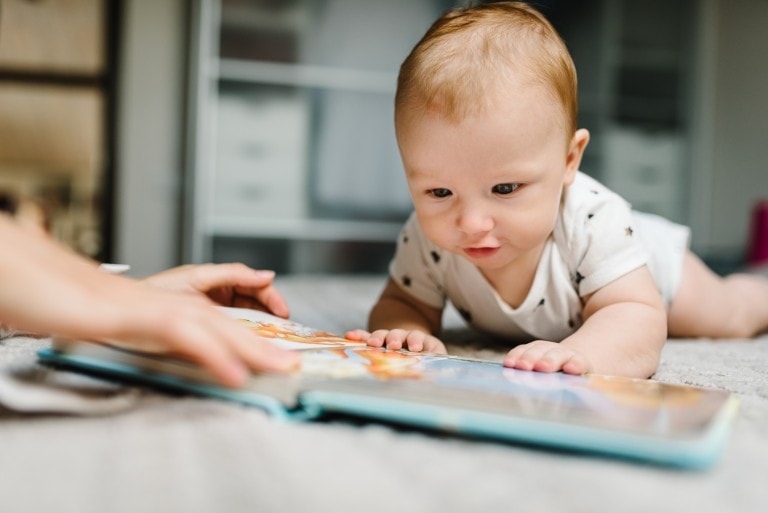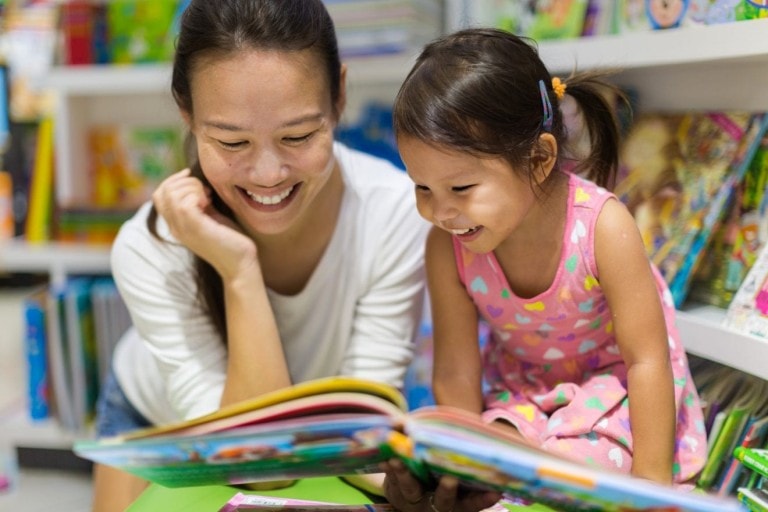While physical growth is accelerated during the infancy stage, it tends to move slower during the toddler months. Instead, you will notice your toddler making substantial cognitive and social-emotional intelligence gains. This is a great time to create opportunities for at-home learning!
My son is currently in this stage, and it is amazing watching his little mind make sense of the world around him! You can help your child hone their cognitive and social-emotional intelligence by creating learning opportunities at home. For example, my son has recently taken an interest in counting. I combined his love of being active with his desire to learn how to count by counting the stairs as we practiced walking up and down the stairs.
Creating Learning Opportunities at Home
Some important skills to keep in mind when creating learning opportunities at home are:
Language and Literacy
- Gives book or verbally requests to read
- Turns pages in a book
- Maintains attention during short, simple stories
- Builds vocabulary
- Follows simple commands with or without gestures
Mathematics
- Demonstrates an understanding of cause-and-effect
- Matches containers with appropriate lids or other objects that go together
- Uses a shape sorter with or without assistance
Social-Emotional
- Enjoys praise for accomplishments
- Engages in joint attention (i.e., both child and parent actively reading a book)
- Engages in parallel play (playing near another child or adult but not playing with them)
- Copies frequent actions of adults or other children
Gross/Fine Motor
- Walks independently
- Points with an index finger
- Walks up and down the stairs with assistance
- Scribbles with writing utensils
Lesson Plans for Learning Opportunities at Home: 16-24 Months
Ideally, these learning opportunities should take roughly five to ten minutes, but sometimes moments like walking down the stairs can have a lasting impact. I take comfort in having some control over what and how my son is learning these important skills. Creating learning opportunities at home allows me to ensure that his developmental needs are being met at optimal times, and it strengthens our parent-child bond.
Learning opportunities surround your child, and you can help your child make the most of those moments by recognizing their potential, setting aside a little time, and having some imagination! Here is a sample lesson plan you can use to create learning opportunities at home with your toddler.
Weekly Lesson Plan

Learning Opportunities in Action
Language and Literacy
Reading books
Spend five to ten minutes reading Little Quack Counts by Susan Thompson with your child. Ask your child questions to help strengthen reading comprehension. My son tends to have me read books to him rather than read them independently, so this is also an excellent opportunity to practice independent reading skills.
Materials: Little Quack Counts by Susan Thompson
Mathematics
Counting ducks
Lay a piece of masking tape down on the floor or the table and assist your toddler in placing the ducks on the line. Count the ducks as they are placed on the line. And encourage your child to point to the ducks as they are counted.
Materials: Rubber ducks, masking tape
Matching ducks
Introduce or reinforce the concept of matching with the help of big and little rubber ducks. Identify the big one as the mother duck and the little one as the baby duck. Help your child match the mother and baby ducks together.
Materials: Rubber ducks (various sizes are ideal)
Big and little
Introduce the concept of big and little with rubber ducks of various sizes. Help your child determine which rubber ducks are big and which are little. You can encourage your child to sort the ducks by size for an added challenge.
Materials: Rubber ducks (various sizes are ideal)
Duck roundup
Before implementing this learning opportunity, scatter the rubber ducks around the room. In a concerned yet excited voice, inform your child the ducks have wandered away and need help finding their way back home. Encourage your child to explore the room to find the ducks and bring them back to the designated area. Once all the ducks are found, practice counting skills.
Materials: Rubber ducks
Find the missing duck
A duck has wandered away and gotten lost! Encourage your child to listen to clues to find the hidden duck.
Materials: Rubber duck
Art
Feathered ducks
Your child will experiment with yellow craft feathers, pre-cut duck shapes, glue, and a paintbrush during this learning opportunity. Encourage your child to use their sense of touch to explore the different textured objects. Help your child describe what they are feeling (i.e., soft feathers, sticky glue, smooth paper). Once finished, talk about the duck and practice identifying it by name/sound.
Materials: Pre-cut duck shapes, glue, small paper plate (for glue), yellow craft feathers, paintbrush
Paint the duck
Encourage your child to give the rubber ducks a makeover with some different colored paints and little hands! Help your child work on identifying colors they want to work with by pointing or naming. Once finished, you can let the rubber ducks dry or transition immediately to the duck bath activity.
Materials: Washable, non-toxic paint for children, rubber ducks
Flower art
Using a white piece of paper, purple tissue paper, a green marker, glue, and a paintbrush, your child will attempt to create the flowers Little Quack sees on his adventure. First, help your toddler tear up pieces of the pink tissue paper to use for the flower petals. Then use the paintbrush and glue to attach the petals to the paper. Lastly, use the green marker to create the stems. Ideally, there should be four flowers to match the flowers in the book. Once completed, practice together pointing to and counting the flowers.
Materials: A white piece of paper, glue, a small paper plate (for glue), a paintbrush, purple tissue paper, green marker
Turtle shells
Help your child create the two turtle shells found in the book using large paper plates and green paint. Allow your child to explore the paint with their hands or a paintbrush as they work to spread the paint around the paper. Once finished, let dry and save for another learning opportunity.
Materials: Large paper plates, green paint, and paintbrush (if desired)
Ladybug art
Help your child create the three ladybugs found in the book using black circular stickers, a red marker, and pre-cut ladybug shapes. First, have your child color the ladybug with the red marker, and then allow the opportunity to remove the black circular stickers from its sheet and place them on the ladybugs. Once completed, practice pointing to and counting and identifying them by name.
Materials: Pre-cut ladybug shapes, red marker, black circular stickers
Sensory
Sensory pond
Help your child create a sensory pond with a small bin, water, fish pebbles, and small artificial or real leaves. Once complete, allow your child to explore the sensory pond with rubber ducks. Ask them questions about what they are doing/feeling as they explore.
Materials: Small bin, fish pebbles, water, small artificial or real leaves, rubber ducks
Find more sensory bin ideas here.
Duck bath
After painting the ducks, encourage your child to bathe them with a small bin of water and just a drop of soap. Explain to your child that bathing the rubber ducks makes them clean, just like when they take baths.
Materials: Rubber ducks, a small bin of water, dish soap
Duck sounds
Spend some time with your child listening to duck sounds. As you both listen to the duck sounds, encourage your child to imitate the sounds.
Materials: Duck sounds
Pond life
Before this learning opportunity, cut a foot-long piece of blue cellophane and tape it to a window. Help your child create a pond life scene using stickers of pond-life-themed stickers. As your child places the stickers on the cellophane, encourage them to identify and count what they see.
Materials: Roll of blue cellophane, masking tape, pond-life-themed stickers.
Feather bin
Help your child create a feather sensory bin using a small bin and yellow craft feathers. Spend some time talking about how the feather feels and practice those counting skills as high as your child can.
Materials: Yellow craft feathers, small bin
Dramatic Play
Hop like a frog
Help your child transform into a frog and encourage them to hop around like a frog! To add to the experience, play some frog sounds in the background. For some children, modeling the intended behavior may be necessary.
Materials: Frog sounds (if desired)
Waddle like a duck
Encourage your toddler to act like one of the ducks in the book as they waddle around the room. If desired, play the duck sounds in the background to add to the experience. For some children modeling the intended behavior may be necessary.
Materials: Duck sounds (if desired)
Buzz like a bee
Help your child find their inner bee as they buzz around the room! Bees like to pollinate flowers, so be sure to have on hand those flowers made during art time! If using the flowers, this would be a great opportunity to reinforce those counting skills.
Materials: Flower art activity (optional)
Slow like a turtle
Using those turtle shells created during art time, tape one on your child’s back and on your back, and crawl around slowly like turtles.
Materials: Turtle shells completed during art time
Little Quack’s adventure
Using pre-printed images of creatures and things Little Quack passes on his adventure, set up a room in your house to re-create this adventure for your child. Encourage your child to practice counting skills along the way.
Materials: Pre-printed images of creatures/things from the book
The takeaway
Creating learning opportunities at home allows parents to take advantage of everyday moments and make them teachable. For example, my son and I would read a book together, and then I would use the book as my inspiration for creating a series of activities. Even when reading the book alone, we would pause to explore or reinforce the concepts that were in the story.
The great thing about these at-home learning opportunities is that they can be implemented according to the family’s schedule. As a preschool teacher, I would often hear parents speak in awe of teachers and how creative we can be with our lesson plans. Like creating a lesson plan for a preschool classroom, creating learning opportunities at home is as easy as having the materials, a little time, and some imagination!






























